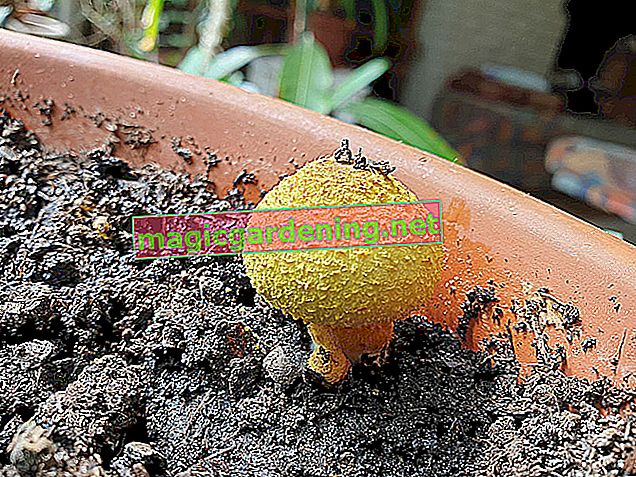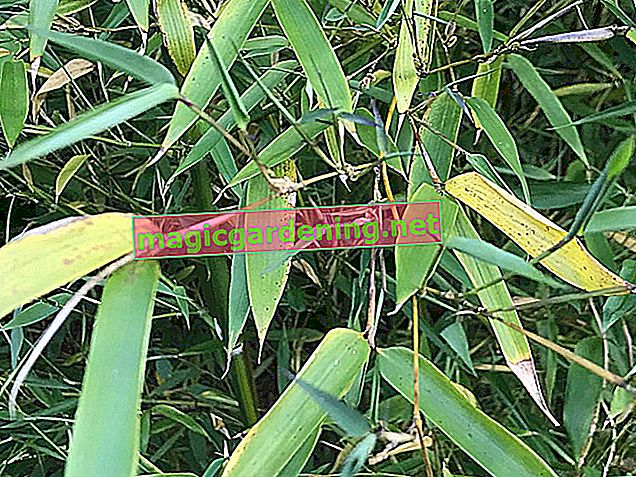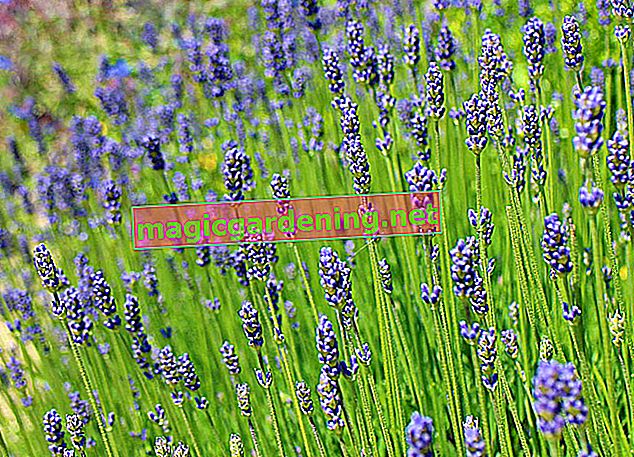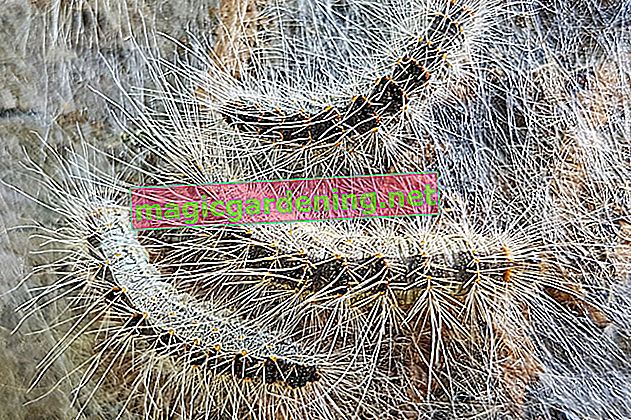
the essentials in brief
- The cabbage white butterfly lays its eggs on cabbage plants and other cruciferous plants. Nasturtiums are also at risk.
- The caterpillars eat both the leaves and the actual plants bare and cause great damage.
- Targeted prevention is most effective, for example through plant protection nets and regular collection of eggs and caterpillars.
- Even strongly fragrant plants, placed in mixed culture between endangered plants, keep the butterfly from laying eggs.
Recognize cabbage white butterfly
“The” cabbage white butterfly does not exist, because it is a matter of two different species from the family of white flies (lat. Pieridae). The large cabbage white butterfly (Latin: Pieris brassicae) has a whitish-yellow color and typically lays its eggs in clutches of up to 200 pieces. The yellow-green and black-spotted caterpillars can be up to two inches long. The little cabbage white butterfly (Latin: Pieris rapae) is not necessarily smaller than its “large” relative, but it can be distinguished from them by some other characteristics. This species lays its eggs one at a time, and the light green caterpillars remain a bit smaller with a length of up to 3.5 centimeters.
also read
- Recognize and fight mealybugs
- Recognize and fight leaf miner on the thuja
- Recognize and fight pests on the apple tree
In this article you will learn how to recognize and differentiate between the two species of cabbage white butterfly. We also provide you with information on the life of butterflies, because knowing this and the resulting prevention is the best protection for your cabbage family. You should be active at the latest when you see the first moths buzzing through the garden in spring - afterwards it does not take long until it is teeming with voracious caterpillars and the first damage to eat becomes visible.
Small or large cabbage white butterfly? similarities and differences

The differences between the large and the small cabbage white butterfly are not particularly great, especially since they occupy the same host plants, cause the same damage and are also controlled in the same way. The small cabbage white butterfly is just a little more common because it is less specialized and therefore has a wider range of food crops at its disposal. The following overview shows you how to differentiate between the two cabbage white species.
| Little cabbage white butterfly | Large cabbage white butterfly | |
|---|---|---|
| Scientific name | Pieris rapae | Pieris brassicae |
| Wingspan | 40 to 50 millimeters | 50 to 60 millimeters |
| Coloring - moth | white with dark gray edges, one or two gray spots on the fore wings, one gray spot on the hind wings | similar, but larger wing spots and more pronounced dark pollination |
| Coloring - caterpillars | light to pale green, yellowish stripes on the sides and back, short hairs, up to three centimeters long | yellowish-green with black spots, up to five centimeters long |
| Occurrence | throughout Germany | throughout Germany |
| distribution | Europe, North Africa | Europe, North Africa |
| Flight times | March to November, up to four generations | March to the end of October, 2 to 3 generations |
| Food plants - moths | Real medicinal valerian, butterfly lilac, meadow foam herb, thistles, catnip | Real medicinal valerian, butterfly lilac, meadow foam herb, thistles, catnip |
| Food plants - caterpillars | mainly all types of cabbage and other cruciferous plants, nasturtiums | mainly all types of cabbage and other cruciferous plants, nasturtiums |
Life cycle
Depending on the weather, the first cabbage whites fly as early as March. The first time the cabbage white butterfly lay eggs in April, the species lays a second time in July. If there is enough food and if the weather (warm and dry) is right, the moths lay one or two more clutches. The great cabbage white butterfly usually lays its eggs for the first time between May and June. This species lays larger clutches, but less often.
The caterpillars hatch about three to four weeks after laying eggs and begin to eat immediately. While the caterpillars of the large cabbage white butterfly mainly eat the leaves, those of the small cabbage white butterfly also gnaw their way into the inside, the so-called heart, of the cabbage family. The animals leave behind numerous traces of excrement that cause the plants to rot and thus make them inedible. After a further four weeks, the caterpillars pupate, only to hatch as butterflies. The greatest damage is usually done in June and July.
Damage

The eggs and caterpillars of the two types of cabbage white butterfly are quite easy to recognize, especially the former can be found either individually (small cabbage white butterfly) or in larger clutches (large cabbage white butterfly) on the underside of the leaves. Immediately after hatching, the caterpillars begin their feeding activity, mainly devouring the leaves:
- The leaves are corroded
- only the leaf skeleton remains
- the actual cabbage is also eaten
- the caterpillars of the little cabbage white butterfly eat their way inside
- Caterpillars and eggs are clearly visible on the plants
- numerous greenish traces of excrement
Cabbage white caterpillars are very voracious and can destroy the entire cabbage harvest within a very short time.
Digression
These pests also occur on cabbage
Not only the two species of cabbage white butterfly like to eat cabbage and related plants. The following butterfly species can also be classified as typical cabbage pests: the cabbage moth or the cabbage moth (lat.Plutella xylostella, caterpillars up to nine millimeters long, green body, brown head), gamma owls (lat.autographa gamma, moth, caterpillars brownish to greenish in color with light yellow stripes and cabbage moth (lat. Evergestis forficalis, caterpillars are small and green). These species are also widespread.How to prevent the cabbage white butterfly

The greatest chance of preventing damage from caterpillars to cabbage plants and other cruciferous plants is through targeted prevention. This includes the following measures in particular:
- From April onwards, regularly check endangered plants for egg clutches and caterpillars
- Remove eggs, collect caterpillars
- Destroy caterpillars or release them in a more suitable location
- Cover endangered plants with plant protection nets
- (alternatively) place tomato plants and other strongly fragrant plants between cabbage
- suitable are e.g. B. many herbs such as thyme, peppermint, sage, anise or mugwort
- very good, for example, as a bed border
- Plant beds with mixed crops at all
Keep a close eye on your garden, especially between April and July, and do more control of the cabbage family if you notice white butterflies. Above all, search the undersides of the leaves for clutches and caterpillars and remove both.
Tips
Incidentally, you can sometimes prevent eggs from being laid by dusting the cabbage leaves with stone flour. However, you have to repeat this measure regularly, especially after a downpour, as the stone dust is removed again by wind and water.
Plant protection nets
Before the first cabbage whites fly, you should cover the beds with the cabbage family (and of course with other endangered plants) with so-called culture protection nets. These offer inexpensive and effective protection not only against cabbage whites, but also against numerous other garden pests. The nets remain on the beds during the entire cultivation period, but you always have to make sure there is enough space under the cover - cabbage plants in particular grow quite tall.
The most important tips for the successful use of culture protection nets:
- Use nets that are as fine-meshed as possible - a maximum of two millimeters in diameter
- Use intact nets, must not have any holes
- Clamp directly after planting or sowing
- ie as early as April if possible
- Avoid loopholes, therefore dig the edges of the net into the ground
- and weight it down with stones
Unfortunately, many a resourceful cabbage white butterfly sometimes still finds a loophole, no matter how well it is hidden. For this reason, you should also check covered plants regularly and collect them if necessary.
Mixed culture and crop rotation
One of the best ways to not necessarily keep cabbage whites away, but to keep the damage as small as possible, is with mixed cultures. This means that you plant various vegetables and herbs in one bed instead of an entire area full of cabbage and other cruciferous plants. In connection with cabbage, particularly strong-smelling plants such as
- tomatoes
- celery
- Onions
- Leeks / leeks
- Tagetes
- thyme
- sage
- rosemary
- basil
- coriander
- or mugwort
for a socialization. Cabbage whites can (hopefully) be confused by the different scent and cannot find the cabbage plants in between. Privet, elderberry or tansy are also very suitable for defense purposes.
With regard to crop rotation, it is important to note that cruciferous plants are not grown on the same bed every year. Instead, you should change the areas and only return to this bed with cabbage and Co. after four years. Good previous crops for kohlrabi, cauliflower, broccoli etc. are, for example, peas, beans, sweet corn and celery. Crop rotation is important in order to contain the population of cabbage white butterflies as far as possible - the pupae like to overwinter near former cabbage plantations.
This video shows how effective a mixed crop with tomatoes can be or sometimes not.
YoutubeOutsmart cabbage whites
Cabbage whites can allegedly be prevented from laying their eggs on the cabbage plants with a simple trick: simply place larger, white eggshells between and on top of the endangered plants. The female cabbage white butterfly looking for a suitable laying place now thinks that other conspecifics would lay their eggs at this point and therefore looks for another place. Whether this method works or not, you can try it out. However, you would probably have to refill the eggshells regularly, as the moths eventually fly into autumn and then also lay eggs.
Mulching against the cabbage white butterfly
Some gardeners claim that cabbage whites can be deterred from laying eggs with strongly smelling or toxic mulch materials. You can use fresh tomato shoots for this, which you simply place between the cabbage plants or hedge trimmings from privet hedges. This should especially help against the second generation of the butterfly, which flies around mid-July. At this point the hedge must also be cut. Simply place the hedge trimmings as mulch (€ 213.00 at Amazon *) between the endangered cabbage plants and let it rot there.
Effectively control cabbage white butterfly

Sometimes, however, all precautionary measures do not help and you have to fight the caterpillars that are present. It is important to collect the animals as soon as they are discovered and otherwise take suitable countermeasures. If you wait, the butterfly population and with it the number of voracious caterpillars will quickly increase. Cabbage white butterflies go through about two to four generations in one growing season and therefore reproduce very quickly. This must be prevented.
Are There Effective Home Remedies?
Aside from the options already outlined, there are no really effective home remedies for controlling the cabbage white butterfly. Only a manure made from tansy or wormwood, used as a spray, shows a certain effect. However, these agents are also more likely to be preventive, as eggs or caterpillars that are already present are neither killed nor expelled. Therefore, spray the fermented broths as early as spring if possible and repeat the application at regular intervals until July.
Tips
Usually, the versatile nettle manure helps against pretty much every evil in the garden. Unfortunately, this does not apply to the cabbage white butterfly, because it is actually more attracted by the brew. Ergo, nettle manure does not help against the pest and you have to look for another control measure.
Biological control methods
YoutubeHowever, it is much more effective to rely on natural predators. However, the typical beneficial insects such as songbirds and shrews are not particularly fond of cabbage white caterpillars - they just don't taste good. Instead, you should opt for parasitic wasps (€ 14.59 at Amazon *) of the species Cotesia glomerata or Trichogramma brassicae, which are often used in organic farming. These species parasitize various caterpillars, including the cabbage white butterfly. This means that the parasitic wasps lay their eggs on the caterpillars. After the larvae hatch, the caterpillars serve them as food.
Various ground beetles and predatory beetles also like to eat caterpillars, which is why you should set up suitable hiding places in the garden for them. These feel comfortable under ground cover plants as well as in piles of dead wood, leaves and stones. A cleverly set up insect hotel (€ 8.87 at Amazon *) and numerous umbelliferous plants attract other useful insects that not only keep the cabbage whites, but also other pests at bay.
Digression
Is the cabbage white butterfly poisonous?
In the course of evolution, cabbage plants have developed a basically perfect defense strategy against pests: The mustard oil glycosides contained in the plants and certain enzymes together form toxic degradation products in the body for many living beings, which is why they do not eat plants that are reinforced in this way. However, some animals have adapted, they do not mind these breakdown products and they are immune.This plant poison does not work either in humans or in some butterflies such as the small and large cabbage white butterfly. Quite the opposite: when you eat cabbage, the vegetable toxins accumulate in the caterpillar's body, so that they are in turn protected from predators such as birds. The feathery beneficial insects do not eat cabbage white caterpillars and adult cabbage whites because they would probably have a heavy stomach for them.
Hands off: chemical pesticides
"Poison destroys the ecological balance in the garden and has unpleasant consequences."
Although some chemical agents that are effective against cabbage whites are approved for the home garden, none of them can be recommended with a clear conscience. Many of them not only combat pests, but also important beneficial insects - this applies above all to the insecticides that contain the active ingredient azadirachtin obtained from the neem tree. Others are based on the action of cyhalotrin, which in turn also kills bees.
With the use of such a product you might fight the cabbage whites and their caterpillars, but at the same time ensure that the beneficial insects die and thus upset the biological equilibrium. As a result, there are no beneficial insects - which in turn gives other pests the chance to spread. If you use a chemical to counter it again, a toxic vicious circle is created. Therefore: It is better to rely on targeted prevention and effective (non-toxic) biological methods.
frequently asked Questions
Are there any other small white butterflies besides the cabbage white butterfly?

In addition to the large and the small cabbage white butterfly, there are other white species in Germany, some of which also look very similar and can therefore easily be confused with one another. This is especially true for the very small karst white butterfly (lat. Pieris mannii) with a wingspan of between 40 and 46 millimeters, which is primarily native to southern Europe to southwest Germany.
A close relative is also the green vein white or rapeseed white (lat. Pieris napi), which is somewhat larger with a wingspan of around 50 millimeters and mainly feeds on rapeseed plants. It is less well known that species such as the conspicuous aurora butterfly (Latin Anthocharis cardamines), the rare postillon (Latin Colias croceus) and the more common brimstone butterfly (Latin Gonepteryx rhamni) also belong to the family of whites (Latin Pieridae).
How old does a cabbage white butterfly get?
Cabbage white flies only live briefly: The caterpillar stage lasts about four weeks, after which the animals pupate. The last generation of a year even hibernates as a pupa and only hatches out of the cocoon as a finished butterfly in the following spring. The adult moths then have a life expectancy of around two months.
How do cabbage whites overwinter?
Adult cabbage whites do not overwinter at all, but rather die in autumn at the latest. Only the last generation of caterpillars, which pupate in late summer or autumn, survives the cold season as a pupa and only hatches out of the cocoon in the following spring. These young moths finally establish the new generations and start laying eggs very early in the year - from April or May. The wintering places are often in sheltered places one to three meters above the ground, with fences and walls being particularly popular.
Is the cabbage white butterfly poisonous to humans too?
In fact, both caterpillars and adult moths are not particularly popular with birds. Since the animals feed on cabbage waxes and therefore store large amounts of mustard oils in their bodies, they are simply not tasty for birds and other potential predators. For us humans, however, neither caterpillars nor butterflies are poisonous in any way, after all, we like and tolerate cabbage plants and their hot mustard oils as well.
Tips
Occasionally, it is advisable to just let any chickens that may be present in the garden. We urgently have to advise against this, because the poultry may like to eat caterpillars - but also like to scratch the beds and also like herbs and vegetables to eat.








